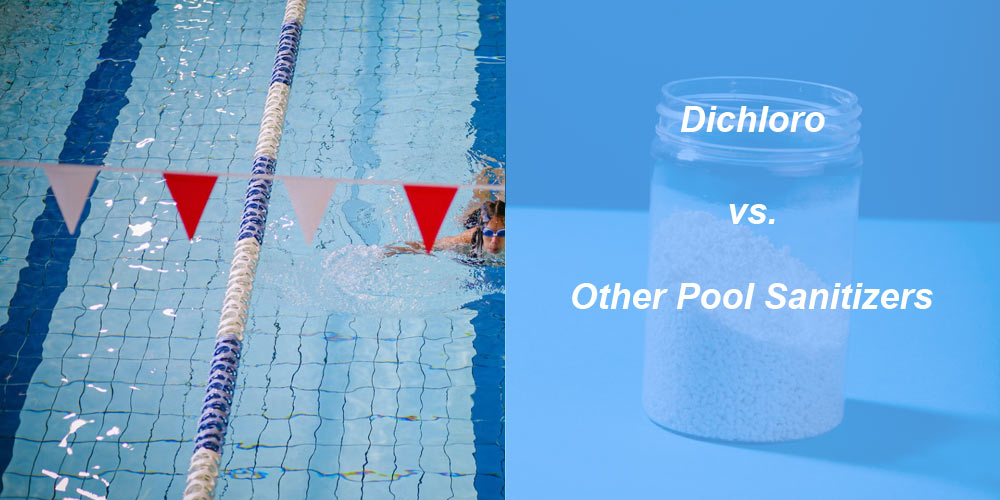Pool disinfectants are essential in pool maintenance. As a pool chemical wholesaler or pool service provider, choosing the right pool disinfectant is crucial to chemical management and pool water quality maintenance. Among pool disinfectants, one of the most popular choices is Dichloro. Dichloro is a fast and efficient chlorine-based disinfectant. But how does Dichloro compare to other pool disinfectants on the market? We will take a deep dive to help dealers make the best choice.
First, we need to understand what Dichloro is? Dichloro, also known as sodium dichloroisocyanurate, has strong oxidizing properties. It is well known for its fast dissolving properties. It can eliminate bacteria, algae and other contaminants. It is often used as a fast and effective pool disinfectant. It is usually used to shock the pool when the water is turbid or algae blooms. And because it contains cyanuric acid, it can still maintain the stability of chlorine under ultraviolet light and is often used for regular disinfection and maintenance of outdoor pools.
Difference between Dichloro and Calcium Hypochlorite
Calcium hypochlorite (commonly known as cal-hypo) is one of the most commonly used pool disinfectants and shock treatment agents. It is an excellent disinfectant that has been in use for decades. However, Dichloro has several advantages over calcium hypochlorite, especially in terms of usability in different water conditions.
Stability:
Dichloro produces cyanuric acid when it dissolves, allowing the pool to maintain a stable chlorine content for a long time even in the sun. Calcium hypochlorite does not contain cyanuric acid, so it needs to be used with cyanuric acid when used, especially in outdoor pools.
Solubility and Ease of Use:
Dichloro is highly soluble in water, which means it dissolves quickly and starts working immediately. In contrast, calcium hypochlorite will have a certain amount of insoluble matter when it dissolves, and it is necessary to take the supernatant after the dissolution and sedimentation.
Shelf Life
Dichlorine typically has a shelf life of 2-3 years. It is highly stable under normal storage conditions, ensuring a longer shelf life and consistent performance. Calcium hypochlorite loses more than 6% of available chlorine per year, so its shelf life is one to two years.
Storage Safety:
Calcium hypochlorite is a known high-hazard substance. It will smoke and catch fire when mixed with grease, glycerin or other flammable substances. When heated to 70°C by fire or sunlight, it may decompose rapidly and become dangerous. Therefore, users must be extremely careful when storing and using it.
For bulk buyers and distributors, SDIC offers better long-term stability, especially when you need to store large quantities of pool chemicals for extended periods of time. Proper storage of both chemicals is essential to maximize their effectiveness and ensure their safe use.
pH Control:
One of the main differences between Dichloro and calcium hypochlorite is the effect on pH. Dichloro is more stable and less likely to cause large fluctuations in pH. In contrast, calcium hypochlorite has a higher pH and may require additional pH balancing chemicals after use, which increases maintenance costs and workload. For pool service providers, this makes Dichloro the first choice for easy and consistent water management.
Dichloro vs. Tri-Chlor: What is the difference
Another popular pool disinfectant is trichloroisocyanuric acid (Tri-Chlor). Tri-Chlor tablets are often used in automatic chlorinators or floaters to provide a continuous release of chlorine. While Tri-Chlor is effective for continuous disinfection of pools, Dichloro has its advantages for shock treatments and certain pool care needs.
Dissolution Rate:
Dichloro dissolves quickly in water, making it ideal for everyday manual adjustments. shock treatments that require rapid chlorination. On the other hand, Tri-Chlor tablets dissolve slowly, which may be good for maintaining chlorine levels over time, but not for rapid disinfection needs.
Dichloro Shock vs. Non-Chlor Shock: Which to Choose
Non-chlorine shock is another alternative to chlorine-based shock treatments. It typically contains potassium peroxymonosulfate, which oxidizes contaminants in pool water without adding chlorine.
While non-chlorine shock is gentler on swimmers and does not increase chlorine levels, it does not disinfect as effectively as chlorine-based options like Dichloro Shock.
Non-chlorine shock tends to cost more per treatment than Dichloro Shock. For bulk buyers, chlorine-based options like Dichloro Shock often offer a more cost-effective solution, especially when considering the added benefits of disinfection and oxidation in one product.
When buying pool disinfectants in bulk, businesses need a product that is reliable, effective, and cost-effective. Yuncang Dichloro is an ideal choice due to its fast dissolution, stable pH, and low risk of scaling. It performs well in both residential and commercial pool settings.
For bulk buyers seeking long-term value, Dichloro delivers consistent, effective results while reducing the need for additional chemicals and maintenance. It is a versatile product that works well for both emergency shock treatments and regular pool care.
Post time: Feb-12-2025

